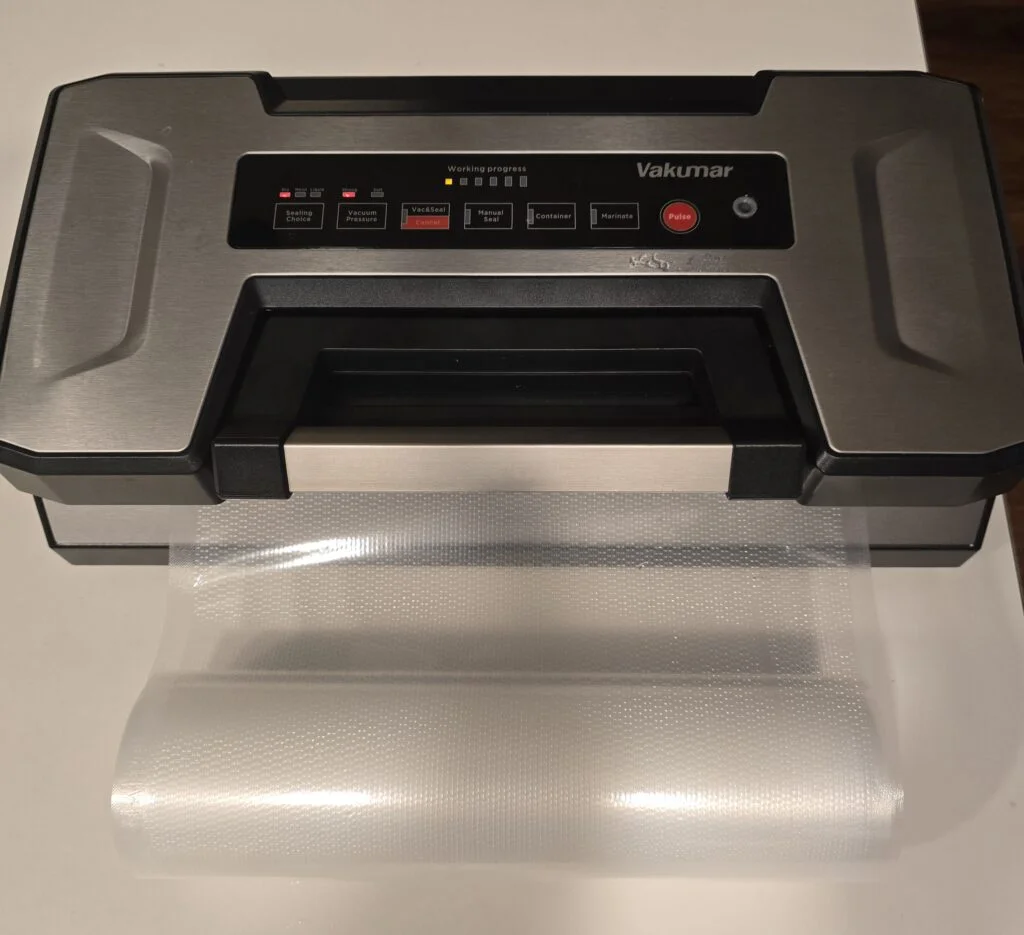Vacuum Sealing


Vacuum Sealing Tips
Although a vacuum sealer is not as essential as a pressure cooker, it is very convenient. You can do sous vide without vacuum-sealed food, but it’s less flexible. You can save money by buying in bulk, separating, and packaging portions. For example, processed, packaged chicken breasts are usually at least twice the price of a whole chicken, even from the same source. There are many YouTube videos demonstrating how to cut up a chicken or turkey. A vacuum sealer makes it easy to store these items in the freezer, and with the sous vide cooking method, food goes straight from the freezer into the water. No defrosting is needed. Eliminate the expense of pre-cut meat and use the savings to pay for the vacuum sealer. The same applies to buying a whole roast versus individually cut steaks. For example, the recent price of grass-fed rib-eye steak was $25 per pound. The same ribeye roast cost $18 per pound. That’s a 28% savings on the same exact meat product! Many other roasts can be cut into steaks for similar savings.
Tip #1: Use more bag than you think you need. If your meat is 4 inches wide, use a bag that is at least 6 inches wide, starting at the seal line. The bag will get pulled into the meat during the vacuum process, so the extra material is needed.
Tip #2: Fold the open edges back about an inch (2.5 cm) before putting the meat in the bag. This will keep the sealing area dry. Any liquid in the sealing area will disrupt the heating process, causing the seal to fail. If this happens, start fresh with a new bag.
Tip #3: Place the cut edge into the drip tray before closing the lid to seal. This will ensure that any liquid pulled up to the edge is caught in the drip tray and not pulled deeper into the machine. The drip tray is removable for cleaning. If the meat is wet, pat it dry with a paper towel before placing it in the bag. Most machines have a “moist” setting that helps with fresh meat.
Tip #4: Seals can fail. If you take the meat out of the freezer and the bag is loose, open it and put the meat in a new bag before cooking. Do not attempt to cook with a damaged seal.
Tip #5: The heat strip needs to cool down a bit between uses. Open the lid fully after sealing to allow it to cool before sealing the next bag. If the strip gets too hot, it will seal before the vacuum can start. If this happens, discard the bag and start over with a fresh bag once the strip has cooled off. Although it seems efficient to cut and bag all the pieces at once, this will not work because the strip will overheat. I usually make a couple of bags from the roll, then prepare some meat. Then, I make a couple more bags and bag and seal one piece at a time. Making a bag from the roll also requires a seal.
Tip #6: You can buy precut bags, and they are convenient. However, I find that they don’t fit many types of meat. It is more efficient to buy an uncut roll and cut and seal bags as needed. To seal an end, place it in the machine and press the “seal” button instead of the “vacuum” button.
Tip #7: There are 11-inch and 8-inch uncut rolls available. I like having both sizes on hand for different cuts of meat. If you prefer only one size, I suggest the 11-inch width.
Tip #8: Don’t be afraid to put more than one piece of meat in the same bag. For example, I like to put both turkey wings in one bag. Leave a space between them and keep them separate with your fingers during sealing. Any two meats with the same cooking time and temperature can be combined. If you always cook both drumsticks, it makes sense to put them in one bag.
Tip #9: Help the vacuum system by squeezing out the air during the sealing process. This is especially useful for a brick of lamb chops. I squeeze them together during the sealing process to eliminate as much air as possible. Large cuts of meat, such as a tri-tip roast, can form small pockets in the bag. Press these out during vacuum sealing for a better fit.
Tip #10: Don’t try to seal meat with an air pocket, such as an entire chicken. Meats cook at different temperatures, and there is no good way to fill the cavity. You can separate the “crown” of the chicken or turkey and cook it whole. It looks great, too.
Tip #11: You can stop the vacuum at any time by pressing the “Seal” button. This is necessary for soft meats, such as fresh fish. Start the vacuum and watch carefully. As soon as the air is removed and the liquid begins to flow toward the machine, press the “Seal” button.
Tip #12: Most machines do not have a cancel or stop button. Once the process starts, the machine will automatically vacuum, seal, and release when finished. If something seems wrong, such as the motor running but the bag not deflating, unlatch the cover to stop the machine. Check the bag for wrinkles or folds. Consider using a new bag.

